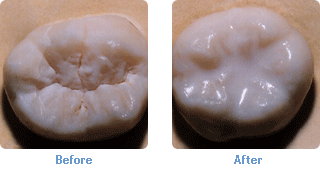So you have a tooth that has a cavity and needs a filling. Now what?
Most people know that the two most common options are tooth colored fillings (called composite fillings) and silver fillings (called amalgam fillings). And most people would agree that the composite fillings are much more aesthetically pleasing than the amalgam fillings. Some patients prefer not to have amalgam fillings because they contain mercery. However, it is important to note that ongoing scientific studies conducted over the past 100 years continue to show that amalgam fillings are not harmful. Sometimes the aesthetic outcome is reason enough to choose a tooth colored filling, especially when the tooth is one that is visible when the patient smiles.
But there are other important reasons that most Apex Dentists these days are choosing to use tooth colored composite fillings rather than amalgam. And these reasons have to do with the major difference in the way they are placed in the mouth.
Composite fillings are resin-based and are chemically bonded to the tooth. Amalgams are not. They are held in place due to a physical retention. This means that after the dentist removes the decay, he also has to remove additional healthy tooth structure in order to create the proper undercuts and retention grooves to hold the amalgam in place. This process leaves less remaining tooth structure.
The good thing is that amalgams usually lasts for a really long time. The bad news is that when they do wear out, they tend to cause larger problems because there is less tooth structure remaining to work with. That is why it is common for a very large amalgam to be replaced with a crown.
If a tooth has a composite filling, the dentist is able to be very conservative in how much tooth structure
he/she removes other than the decay. This could mean that years later when the composite filling eventually wears out, hopefully another larger composite filling can be placed, rather than a crown.
Another common issue is that teeth with old amalgams tend to develop more cracks. Because the amalgam filling is not bonded to the tooth, the enamel surrounding the filling is unsupported. Over time, that unsupported tooth structure microscopically flexes when stress is placed on the tooth. Years of this flexing can cause cracks to form. These cracks can lead to more extensive (and expensive) treatment, such as a crown, a root canal, or even loss of the tooth depending on the severity of the fracture.
Whether you have composite or amalgam fillings it is important to maintain your regular cleaning and check-up appointments with your Apex dentist. He/she can keep you informed about the condition of your fillings. That way when one does wear out (and they will, because unfortunately no dental work lasts forever), you can be pro-active, which typically leads to a less expensive and more conservative outcome.




 How long do sealants lasts?
How long do sealants lasts?
 Bottomline: The best thing you can drink is water.
Bottomline: The best thing you can drink is water.